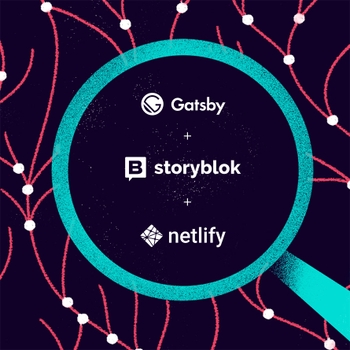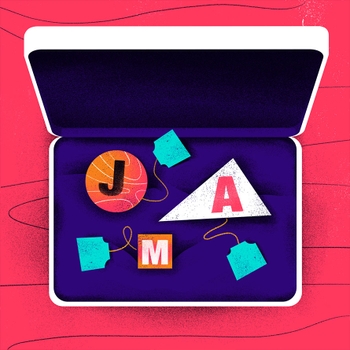- 5 min to read
Jamstack rage, Gandalf, and Apple - 2019 in a nutshell
The transition period between old and new year always comes with a scent of melancholy, which, once settled in our minds, triggers introspection. It wasn’t any different for me this year.

While reflecting on 2019 alone, I couldn’t resist recalling the previous years as well. I reminded myself of 2017 when our three-person army built first ‘scrappy’ sites with Hugo and Next.js, when we realized that what we do is often referred to as “Jamstack” by others in the worldwide dev-community. That’s when we first noticed that there are more lunatics on the web who use static site generators (and joined the TheNewDynamic slack to e-meet them).
2019 brought a number of significant breakthroughs to all the believers of the serverless and decoupled front-ends. This short article is an attempt to sum up the events which (IMHO) were significant in the past 12 months.

The Web is Changed
As Galadriel once famously said, the web is changed, and we can feel it on so many levels today. Whereas she’s been mostly referring to the negative impact she felt happening, I’d like to outline a couple of primarily positive ones below.
I Feel it on the Front-end
One particular change we all should be excited about is the adoption rate of Jamstack tools on the World Wide Web. The difference is more apparent if we focus on the sites with the highest traffic.
To put things in perspective websites built with the most popular (and identifiable) static site generators out there account for 4.89% of 10k websites with the highest traffic in January 2020 (based on data from Builtwith.com). That is a significant increase if we compare it to barely 1.70% at the beginning of the last year. The Jamstack momentum is here, and I can not see any premises to assume a slowdown in the coming months.
Gatsby, the Coolest Kid in Town
Gatsby remained “the coolest kid in town” throughout 2019 with lots of bug fixes, updates, and a couple of notable milestones. We experienced the release of a stable version of Gatsby Themes, could join the open beta for Gatsby Preview, and (what’s probably the most promising from all of these) we’ve seen the announcement of a dedicated cloud for Gatsby.
It’s also worth mentioning that Gatsby (the company) raised another round of funding from CRV - good to see investors being bullish on this paradigm too!
A Busy Year for Next.js
The core team at Next also had a pretty busy and productive year - they managed to publish Next v.8 and v.9 a couple of months later. The new releases gave us a tool more powerful than ever: lots of performance improvements for pre-rendering assets, significantly shorter static-export times, the introduction of serverless Next.js, and baked-in zero-config support for TS: to name only a few new features they introduced.
Our Website
I can’t resist mentioning that we managed to deploy the new Bejamas site in 2019! The web will certainly never be the same again after our deployment of the new version. In case you are curious why this is so radical and why we did what we did and how we did it, read the case study here.
I Feel it on the Back-end
Netlify
One of the most profound updates of 2019 for me, has been the roll-out of Netlify Analytics - analytics service, which in short doesn’t require running any client-side scripts. Hence it also has no impact on the performance of your site or app.
When talking about a better DX, we shouldn’t miss mentioning the Beta release of Netlify Dev that took place earlier last year.
AWS
Bezos’ gang doesn’t want to miss the Jamstack-wave either. Five new features have been released for the AWS Amplify in late November 2019; all mainly focused on improving the workflow and collaboration while setting the backend for your pre-rendered apps.
Vercel
The guys behind one of our beloved frameworks stayed very busy with product updates too. One of the very intriguing concepts presented to us in 2019 has been the SPR: Serverless pre-rendering. We’ve been already faced with a use-case where going with this approach made perfect sense, and it added lots of value to us as well as the end-customer!
Apart from that, we have a whole bunch of new CDN and origin regions when using Vercel, which effectively leads to better performance of the apps and sites across the globe.
If you’re obsessed with good workflow and collaboration experience across the board, it’s worth mentioning the release of Vercel Integrations Marketplace as well.
I Smell it in the Air
Jamstack Community is Stronger Than Ever
The circle of Jamstack preachers became much much bigger in 2019 - no doubt about it. Last year gave birth to at least 19 new local Jamstack communities, and we had a chance to join three official Jamstack conferences organized by Netlify in 2 new locations, which certainly is an excellent way to connect with like-minded people!
On the other hand, folks at Vercel prepared something for those of you who don’t like or can not travel too much. A fully remote conference focused on covering the topics of modern web development tools and best practices: Backendless Conf. Recordings from that conference are available online for you to watch.
When talking about what to listen to and watch from 2019, be sure to check That’sMyJamstack from Bryan Robinson. It is a podcast where lots of different people from the Jamstack community are invited to talk about the impact JAM made on their work and many similar topics. Make sure to check it out if you want to hear some JAM in your earpods!
Apple’s Slowly (but surely) Letting PWAs Sink Into iPhones and iPads
If you’ve been following us for a while, you know we’re very enthusiastic about the concept behind Progressive Web Apps, also called Home Screen Web Apps, because surprisingly, Apple coined their own term for those.
2019 brought us iOS13, and it was great to see more enablement for PWA features on Apples’ mobile platform. One of the significant usability updates includes the support for Apple Pay in PWAs on Apple devices. It’s also worth remarking that the “native app” feeling has increased by a notch: the dark mode is available by default, and PWAs now can run in the background on our iPhones.
To sum up this part in Gandalf’s own words:
The great storm is coming, but the tide has turned.

Let’s hope his words will be prophetic as they once were for the middle-earth.
What’s Been Going on at the Fellowship of Bejamas, Though?
We’ve been very positive from the early stages of this paradigm shift about the beneficial impact the decoupled approach can make on companies of different sizes. The seeds we’ve been planting for so long started to come to fruition.
In 2019 Bejamas managed to ship over 20 new Jamstack web development projects (PWAs, marketing websites, and e-commerce shops combined) to small, medium as well as enterprise businesses. The extraordinary surge of workload led us into endless hiring, which had an almost tripling effect on the count of our team members.
Today, Bejamas counts 18 full-time members, whereas, at the end of 2018, we’ve been just a team of seven (we have a couple of open positions, go check our career page if you’re curious).
We plan to strengthen our core in the months to come, but also extend a bit the scope of services we’ve been offering to our customers thus far (we’ve been solely focusing on web development, together with QA and project management).
Galadriel’s Wisdom (yet again)
I read somewhere that one should always close the article with an impactful quote, so here we go. To paraphrase the wise lady Galadriel ( again):
For the time will soon come when Jamstackers will shape the fortunes of all.
Let’s live up to that statement in 2020 and shape the web in a better, faster, modern way.



